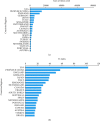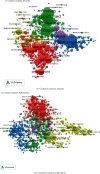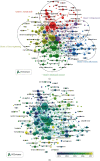Global Research Trends in Tendon Stem Cells from 1991 to 2020: A Bibliometric and Visualized Study
- PMID: 35765660
- PMCID: PMC9233735
- DOI: 10.1155/2022/7937765
Global Research Trends in Tendon Stem Cells from 1991 to 2020: A Bibliometric and Visualized Study
Abstract
Background: Tendinopathy is a disabling musculoskeletal disorder affecting the athletics and general populations. There have been increased studies using stem cells in treating tendon diseases. The aim of this bibliometric and visualized study is to comprehensively investigate the current status and global trends of research in tendon stem cells.
Methods: Publications related to tendon stem cells from 1991 to 2020 were retrieved from Web of Science and then indexed using a bibliometric methodology. VOSviewer software was used to conduct the visualized study, including coauthorship, cocitation, and cooccurrence analysis and to analyze the publication trends of research in tendon stem cells.
Results: In total, 2492 articles were included and the number of publications increased annually worldwide. The United States made the largest contribution to this field, with the most publications (938 papers, 37.64%), citation frequency (68,195 times), and the highest H-index (103). The most contributive institutions were University of Pittsburgh (96 papers), Zhejiang University (70 papers), Shanghai Jiao Tong University, and Chinese University of Hong Kong (both 64 papers). The Journal of Orthopaedic Research published the most relative articles. Studies could be classified into five clusters: "Animal study," "Tissue engineering," "Clinical study," "Mechanism research," and "Stem cells research", which show a balanced development trend.
Conclusion: Publications on tendon stem cells may reached a platform based on current global trends. According to the inherent changes of hotspots in each cluster and the possibilities of cross-research, the research in tendon stem cells may exist a balanced development trend.
Copyright © 2022 Huibin Long et al.
Conflict of interest statement
The authors declare that there are no conflicts of interest regarding the publication of this paper.
Figures






Similar articles
-
Global research trends in extracellular vesicles based on stem cells from 1991 to 2021: A bibliometric and visualized study.Front Bioeng Biotechnol. 2022 Aug 30;10:956058. doi: 10.3389/fbioe.2022.956058. eCollection 2022. Front Bioeng Biotechnol. 2022. PMID: 36110319 Free PMC article.
-
Global research trends in stem cells for osteoarthritis: a bibliometric and visualized study.Int J Rheum Dis. 2018 Jul;21(7):1372-1384. doi: 10.1111/1756-185X.13327. Int J Rheum Dis. 2018. PMID: 29968331
-
The primary total knee arthroplasty: a global analysis.J Orthop Surg Res. 2020 May 26;15(1):190. doi: 10.1186/s13018-020-01707-5. J Orthop Surg Res. 2020. PMID: 32456654 Free PMC article.
-
Global scientific trends on the immunomodulation of mesenchymal stem cells in the 21st century: A bibliometric and visualized analysis.Front Immunol. 2022 Aug 24;13:984984. doi: 10.3389/fimmu.2022.984984. eCollection 2022. Front Immunol. 2022. PMID: 36090982 Free PMC article. Review.
-
Global research status of pathological scar reported over the period 2001-2021: A 20-year bibliometric analysis.Int Wound J. 2023 May;20(5):1725-1738. doi: 10.1111/iwj.13988. Epub 2022 Oct 23. Int Wound J. 2023. PMID: 36274191 Free PMC article. Review.
Cited by
-
Global research trends and hotspots on tendon-derived stem cell: a bibliometric visualization study.Front Bioeng Biotechnol. 2024 Jan 8;11:1327027. doi: 10.3389/fbioe.2023.1327027. eCollection 2023. Front Bioeng Biotechnol. 2024. PMID: 38260747 Free PMC article.
-
An overview of the material science and knowledge of nanomedicine, bioscaffolds, and tissue engineering for tendon restoration.Front Bioeng Biotechnol. 2023 Jun 14;11:1199220. doi: 10.3389/fbioe.2023.1199220. eCollection 2023. Front Bioeng Biotechnol. 2023. PMID: 37388772 Free PMC article. Review.
-
Historical evolution, hotspots, and trends in tendon tissue engineering: A bibliometric analysis.Regen Ther. 2025 May 6;29:600-612. doi: 10.1016/j.reth.2025.04.009. eCollection 2025 Jun. Regen Ther. 2025. PMID: 40487919 Free PMC article.
References
LinkOut - more resources
Full Text Sources

